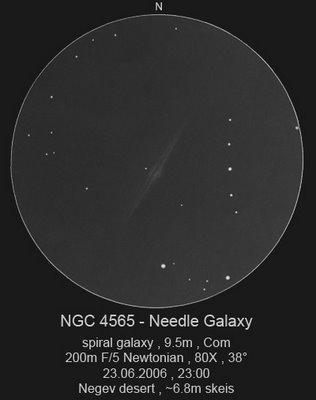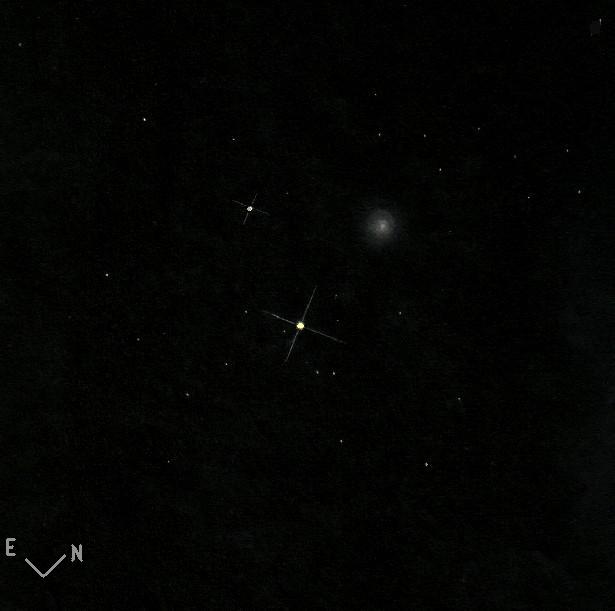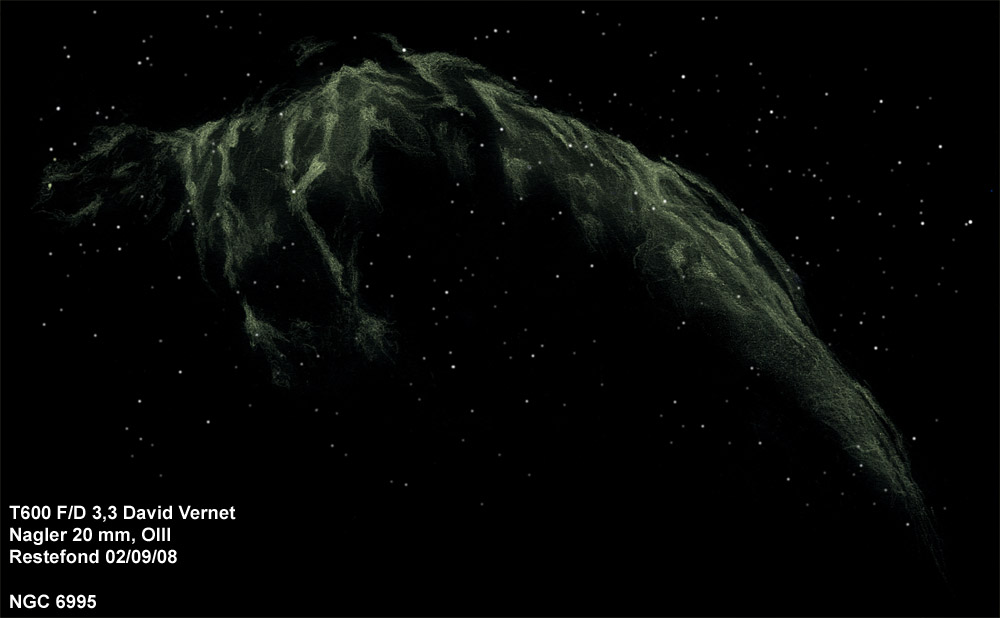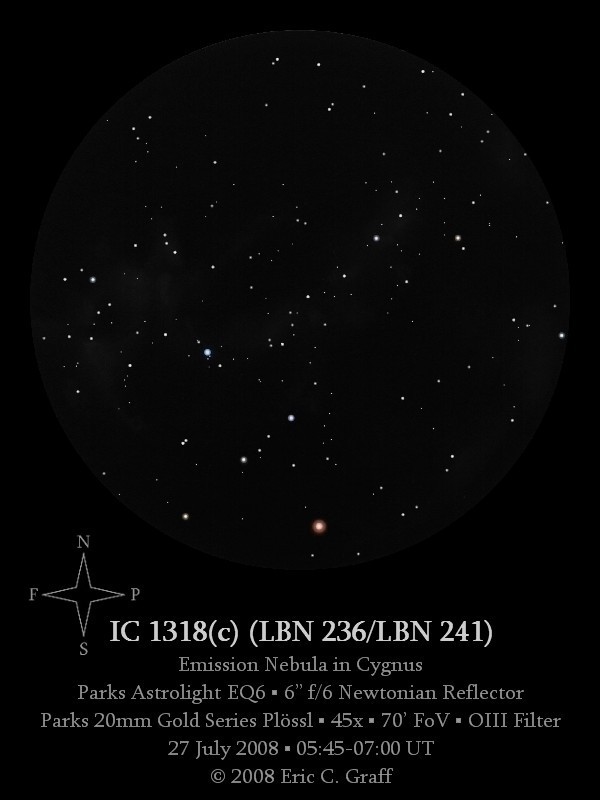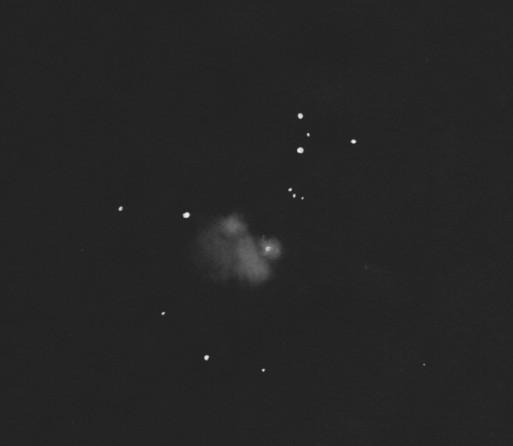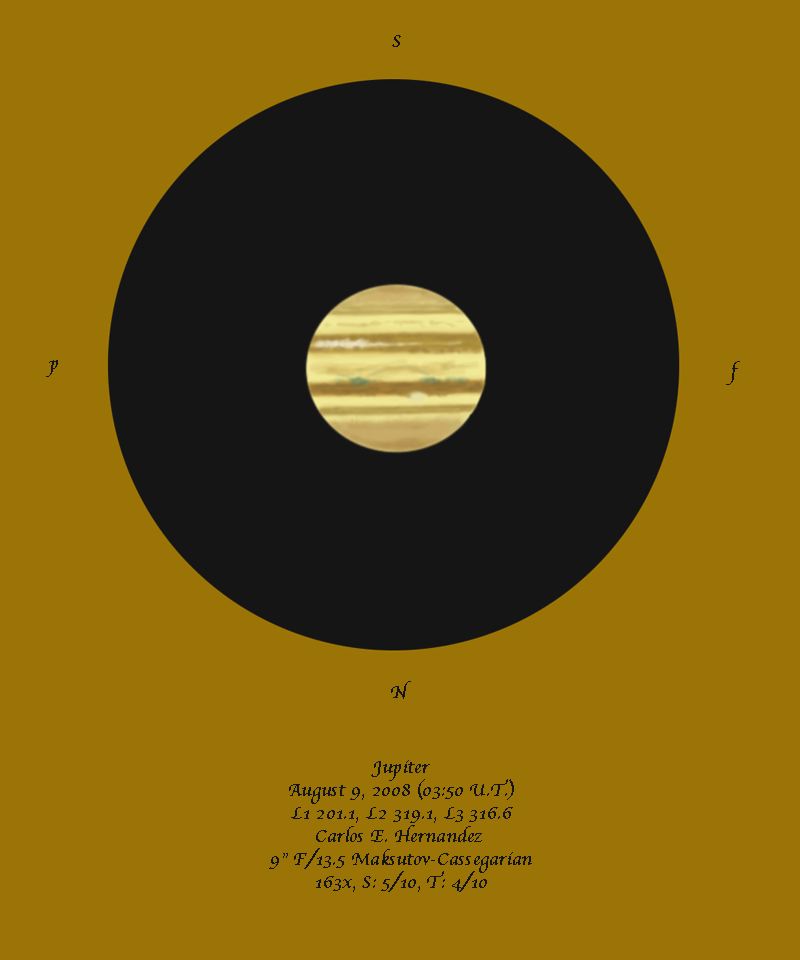NGC 4565
Sketch by Michael Vlasov
Mirach and its Ghost
Mirach and NGC 404
Sketch and details by Frank McCabe
As the constellation Andromeda climbed high in the eastern sky, I used this opportunity to sketch dwarf spiral galaxy NGC 404 and nearby second magnitude star Beta Andromedae (Mirach). Beta Andromeda is a red giant star of class M0 III and 199 light years from us. This bright star appeared golden to my eye and is a mere 6.5 arc-minutes from its “ghost” the galaxy NGC 404. This 10th magnitude galaxy has been classified as E0, lenticular (a category between elliptical and spiral) and more recently spiral class S0. At a distance of 10 million light years it is 50,000 times further away than Mirach. William Herschel described NGC 404 as a nebula in 1784. The position of galaxy is approximately R.A 1hr 10min, Dec. +35° 37’.
I made this sketch in the early morning of August 31, 2008.
Sketching
Date and Time: 8-31-2008, 5:10-5:40 UT
Scope: 18” f/5 Dobsonian. 175x
8”x11” white recycled sketching paper, 4B soft charcoal pencil, HB hard charcoal pencil, blending stump, eraser shield, drawing re-sketched indoors because of much smudging, scanned and inverted, some star magnitude adjustments made after scanning using Microsoft Paint.
Seeing: Pickering 7/10
Transparency: Above Average 4/5
Nelm: 4.8
Frank McCabe
Bones of the Veil
NGC 6995
Sketch by Serge Vieillard
Serge Vieillard used a 60 cm telescope to observe the Veil Nebula on September 2 from Restefond. He notes that his drawing is really a pale reflection the extraordinary sight through the telescope, where the nebula was large, obvious and extremely detailed. Every detail was complex in structure, and evoked the sense of bones in three-dimensional relief. So that he could focus on observing and drawing the nebula, Serge used an astrophoto to generate the star field.
A Serpent Among the Stars
Barnard 68 and 72 (The Snake Nebula)
Sketch and Details by Kiminori Ikebe
B68 Oph dark nebula Difficulty level: 3/5
B72 Oph dark nebula Difficulty level: 4/5
The Snake Nebula
Date of Observation: 2002/08/02 22:51
Observing Site: Gokase
Transparency/Seeing/sky darkness: 5/2/5
Instruments: 50cm Dobsonian and XL40
Magnification: 60x
Width of field: 1.1 degrees
These are good photographic objects but difficult visually.
There are numerous faint stars in the field, although they are not as dense as in the center of the Milky Way Galaxy. Against this background a dark nebula shaped ‘S’ is visible faintly. The southern part of the winding dark nebula is wide and clear. It is conspicuous because the background is bright. It is not curved smoothly but bent sharply at two places. The northern part is bent at one place. The end of the northern part is not clear. There is a small separate dark nebula visible southwest of the Snake Nebula. This is B68. This is more clearly seen than the Snake Nebula because the background is bright. It is triangular with its corners being roundish.
A Smoky Cascade
IC 1318(c)
Sketch and Details by Eric Graff
Object Name: IC 1318(c) (West Extension)
Also Known As: LBN 236, LBN 240, LBN 241, DWB 52, GAL 077.7+03.4
Object Type: Emission Nebula
Constellation: Cygnus
Right Ascension (2000.0): 20h 17.1m
Declination (2000.0): +40° 50′
Magnitude: —
Size: 40′ x 25′
Date/Time: 27 July 2008 • 05:45 to 07:00 UT
Location: Oakzanita Springs, San Diego Co., California, USA
Telescope: Parks Astrolight EQ6 • 6″ f/6 Newtonian Reflector
Eyepiece/Magnification: Parks 20mm Gold Series Plössl • 45x • 70′ FoV
Filters: Lumicon OIII
Conditions: Clear, Calm, 64°F
Seeing: Pickering 6-7
Transparency: NELM 6.4; TLM 14.2
This cascade of stars shrouded in smoky wisps of nebulosity caught my attention as I made the star hop from Gamma Cygni to IC 1318(b). The cascade ends at the sparse open cluster Collinder 419, whose brightest star is a close pair known as Struve 2666 (6.0, 8.2; 2.6″; 245°). Just northeast of this cluster the narrow stream of nebulosity blossoms into a hazy morass of delicate nebulosity – this is IC 1318(c). Fifth magnitude HD 193092 blazes with a reddish-orange light to the south.
Sketch Info: Nebulosity sketched with graphite applied with artist chamois and blending stump on 24# paper in 7½” circle. Stars with pencil and ink, cleaned up digitally (and colorized) in Microsoft Picture It!
Now You See It, Now You Don’t
NGC 6826
Sketch and details by Dale Holt
These day virtually all of my deep sky observing is undertaken from my observatory using my 14″ F5 Newtonian coupled with a Watec 120N video camera. I sketch the ‘virtual’ real time image from the black & white monitor display in my office attached to the observatory.
I use an HB pencil, eraser and blending stump on standard cartridge paper. I scan the image and reverse to a negative before storing as a J Peg.
For this drawing of the ‘Blinking Nebula’ NGC 6826 in Cygnus I used a Lumicon UHC filter in front of the camera.
Clear Skies, Dale
Waning Blue
Daytime Moon
Sketch and Details by Frank McCabe
23 Day Old Waning Crescent
When the moon crossed my meridian today it was more than 75° above the southern horizon. That was about one hour before I began this sketch. The last time I purchased sketching paper I bought a few sheets of light blue paper for day time lunar and planet sketching. This August has been unusual for Chicago, Illinois, in that we have had many days with cool temperatures and low humidity. Today again was one of those very transparent days although clouds were frequent and stopped me from sketching from time to time. Actual sketching time was about 45 minutes over a two hour period.
Sketching:
For this sketch I used: light blue drawing paper cut to 12’x14”, white Conte’
pastel pencils, a light blue Crayola pencil, a blending stump and my index finger too. No adjustments were need after scanning except size reduction.
Telescope: 4.25 inch f/ 5 Dobsonian and 12mm eyepiece 45x
Date: 8-24-2008 13:00-15:00 UT
Temperature: 20° C (68° F)
Partly cloudy, calm
Seeing: Antoniadi III
Colongitude: 188°
Phase: 262.9°
Lunation: 23 days
Illumination: 44 %
Libration Latitude -6°
Libration Longitude -1°
Frank McCabe
Octans Triplet
NGC 6438 and 6438A
Sketch by Eiji Kato
The complex multiple galaxy, NGC 6438 lies in the southern constellation Octans. According to analysis by C. J. Donzelli and M. Espindola in NGC 6438: A Triple System?, this may be an interacting triplet (an S0 galaxy and two disc galaxies in a merger) rather than a double system.
Jupiter – August 9, 2008
Jupiter – August 9, 2008
Sketch and Details by Carlos Hernandez
I made an observation of Jupiter on August 9, 2008 using my 9-inch F/13.5 Maksutov-Cassegrain. Much detail was noted over the planet, especially the North Equatorial Belt (NEB) and South Equatorial Belt (SEB). The seeing conditions were above average (5/10) for a short time before the clouds came in and ended my observing session. I welcome any comments that you may have on my observation.
Date (U.T.): August 9, 2008
Time (U.T.): 03:50
L1 201.1, L2 319.1, L3 316.6
Diameter (Equatorial): 46.4″
Instrument: 9-inch (23-cm) F/13.5 Maksutov-Cassegrain
Magnification: 163x
Seeing (1-10): 5, Antoniadi (I-V): III
Transparency (1-6): 4
Notes:
South Polar Region (SPR): Appears dark to dusky (3-4) and mottled.
South Temperate Zone (STZ): Appears thin and shaded (6/10).
South Temperate Belt (STB): Appears dark to dusky (3-4/10), thin and divided (northern component darker than southern). No ovals visible within it.
South Tropical Zone STrZ): Appears bright (7/10) with a thin, dusky (4/10) band over it’s central portion.
South Equatorial Belt (SEB): Appeared dark to dusky (3-4) and containing dark (3/10) dark condensations along it’s northern border and bright (7/10) undulating sections (strips) within it (preceding section wider in latitude than following).
Equatorial Zone (EZ): Appeared shaded to bright (6-7/10) with a thin, dusky (4/10) band across the center of it.
North Equatorial Belt (NEB): Appeared dark to dusky (3-4/10) and thin with dark rods (barges) along it’s northern border. Blue festoons (3/10) noted along it’s southern border.
North Tropical Zone (NTrZ): Appeared bright (7/10), but no other detail visible within it.
North Temperate Belt (NTB): Appeared thin, dark to dusky (3-4/10) and divided by a thin, bright (7/10) zone.
North Polar Region (NPR): Appeared dark to dusky (3-4/10) and mottled.
A digital image made using Photoshop CS3.
The best of luck in your own observations of Jupiter.
Regards,
Carlos
Apochromatic Eagle
M16 – The Eagle Nebula
Sketch by Sue French
Sue French produced this sketch recently with the latest addition to her telescope family. More of Sue’s carefully crafted sketches (including an older sketch of M16) can be found in her book Celestial Sampler and at her website.

